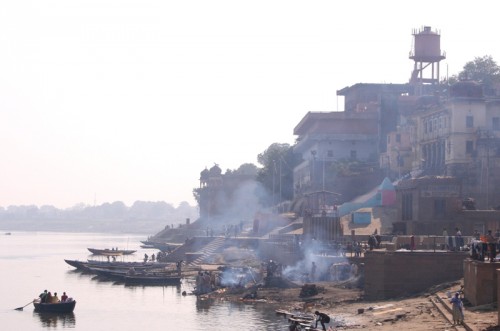First published in the New York Times by SIDDHARTHA MUKHERJEE
It had rained heavily the night before. The steep stone steps of the ghat are slick and slippery, and when my father pulls me onto the boat, the water feels more stable than the ground. The boatman rows out toward the open river, and the city of Varanasi swings into full view.
On the bank, wrestlers are performing calisthenics; a vendor is selling marigolds; a man is throwing birdseed at pigeons. The river moves sluggishly at first — but then a current forces the boat around the bend, and we are floating silently by the Manikarnika ghat, where the dead are burned.
I am 8 or 9 years old. Save a distant uncle who has died of renal failure, I have had no personal experience of death. I imagine it as little more than a corporeal exit from the world.
It is an unforgettable sight: row upon row of burning bodies on wooden pyres by the river’s edge. There are dozens of pyres lighted at the ghat, like lanterns along the river. Around them, a circus of death unfolds. There are sons waiting for a professional barber to shave their heads. Men carry the bodies down to the water.
The bodies, swathed in white cloth and strewn with flowers, are bathed, washed and then taken onto a bedlike pile of wood and set alight. The fires burn sometimes for hours. When the flames begin to sputter, the priest shovels the ashes, still smoldering, into the river. The melodrama of the scene is nearly perfectly offset by the glum, mechanical matter-of-factness of its participants. Mounds of ash and marigold and wood chips are floating all around the boat.
There is a man standing by one of the fires and facing the boat, with his arms still taut, as if holding the body — except he is holding air. I bury my face in my father’s lap, but curiosity, literally morbid, forces me to look and to look again, as we drift past. The scene on the bank is mesmerizing. Then the boat rounds another bend, the haunted tableau vanishes, and we debark at another ghat.
Decades later, having trained as an oncologist in Boston, I attend the funeral service of a woman who has died after a long battle with cancer. I remember approaching the coffin, and then registering something odd: the woman has been coiffed and dressed up, and there is the faintest blush of lipstick — lipstick? — on her mouth.
The eulogies at the service are moving and emotional. But the funeral itself seems cleansed and sanitized into a clinical, nearly forensic, ethereality. There are children in dark suits sitting on the aisles looking like miniature adults. I wonder if any of them will be haunted by this funeral, or dream often about it, as I did after that disorienting vision decades ago.
At medical rounds a few days later, I ask some residents and interns about death: how many have carried the body of a parent? What does the weight feel like? And what about the ritual of bathing and cleansing?
In the United States, most terminally ill men and women die in hospitals or nursing homes. The death is typically “pronounced” by an intern on call. The body is lifted out of its bed by an attendant and wheeled to a morgue by another shift worker in scrubs. Undertakers clean and dress it.
Before a cadre of professionals took over the job, people of many faiths took part in the care of the bodies of the dead. Early Christians typically prepared their dead for burial themselves. The novelist Catherine Madsen writes about the Tahara, a Judaic rite in which bathing the body in warm water is accompanied by the reading of ecstatic love poetry to the dead man or woman. If the ritual were revived today, Madsen predicted that “there would be nervous giggling about . . . necrophilia; the plan would be . . . declared inappropriate and quietly dropped.”
Indeed, when I recount Madsen’s description to the residents, it makes them nervous. Our experience of death has become disembodied. The corpus has vanished from the most corporeal of our rituals — and we are left standing with our hands outstretched and taut but with no counterweight to bear, like the man on the riverbank holding air.
Siddhartha Mukherjee is an assistant professor of medicine in the division of medical oncology at Columbia University. He is the author of “The Emperor of All Maladies: A Biography of Cancer.”
Hat-tip to Beth Knox of Crossings
This website uses cookies so that we can provide you with the best user experience possible. Cookie information is stored in your browser and performs functions such as recognising you when you return to our website and helping our team to understand which sections of the website you find most interesting and useful.


